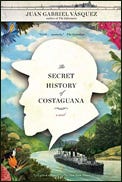In The Secret History of Costaguana, a fictional narrator presents the real story behind Joseph Conrad's novel Nostromo, in which a fictional silver mine in a fictional country (Costaguana) stands in for the sordid history of the Panama Canal. Conrad published Nostromo in 1904, a year after the U.S. government cut a deal to support rebels in northern Colombia, creating the new, breakaway country of Panama. But the story begins fifty years earlier, before the narrator's birth.
José Altamirano is the bastard son of a liberal journalist. In the 1850s, Miguel Altamirano champions the cause of medical students prohibited from dissecting Christian cadavers. A U.S. entrepreneur's ambitious but deadly project to construct an Isthmus-spanning railroad offers the solution: "fifteen barrels full of ice. In each one came a Chinese coolie doubled over and recently deceased from dysentery or malaria, or even cholera, which in Bogotá was now a thing of the past."
The coolie-stuffed barrels lead to a cholera epidemic, José Altamirano's conception, and Miguel Altamirano's new enthusiasm: the French effort "to part the land as Moses parted the sea." But Moses had it easy. Revolutions, disease and escalating expenses plague the canal project. The tropical rainfall is such that a visitor awakens "in a fright, because she thought the city was being bombed." The sides of the partially excavated canal keep collapsing under the onslaughts, "wet and stubborn and impossible like a gigantic clay balcony ripped off the side of a hilltop cottage."
From the beginning, the narrator alludes to his betrayal by his "doppelganger," Joseph Conrad. Enraged by his country's "meddling, despotic, murderous history" and wracked by guilt over his part in its "crucifixion," José finally unloads his story to Conrad, who writes about a silver mine instead. The Secret History of Costaguana is a sprawling, vivid, darkly humorous catalog of betrayals, as chaotic on the surface as Colombian history but with a relentless inner drive that hurtles its "Readers of the Jury" onward to its anguished conclusion. (2007 in the original Spanish, 2011 English edition expertly translated by Anne McLean; 283 pages, including an Author's Note regarding mentioning selected sources)




